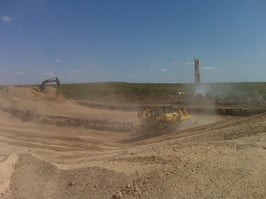Drilling holes in the ground involves more than just putting a drill bit in a vertical, downward position and hitting the on-switch. As the machinery begins drilling into the ground, the materials displaced by the drilling, known as cuttings, needs to come out of the hole. Drilling companies use various circulation materials to grab the cuttings and bring them up to the surface.
What is Direct Rotary Drilling?
Direct rotary drilling utilizes circulation materials sent down the center of the drill pipe and out ports. Air and water are the most common forms of circulation materials used in direct rotary drilling.
Air rotary drilling equipment uses air as its circulation material. The drilling rig sends the compressed air down into the pipe. High pressure air always moves towards low pressure areas. In the case of the bore hole, the low pressure air is at the top. This causes the air to swiftly move towards the surface, taking the drill cuttings with it.
Mud rotary drilling equipment use water as its circulation material. When the water hits the cuttings, it often becomes muddy, thus the name. As the water fills the bore hole, it will start moving towards the surface, bringing the cuttings with it.
When is Mud Drilling a Better Choice than Air Drilling?
Direct air rotary drilling is popular because the drilling equipment is lighter and more maneuverable than many mud drilling rigs. There is no need to find a water source or haul water into the drill site. The drilling rig takes air from the outside, compresses it, and then sends it down the hole. When the air escapes with the cuttings, it disperses back into the air. Clean-up is also a lot easier with air drilling.
However, air drilling does has two major disadvantages: formation fluids and sloughing bore walls.
Formation fluids can include water and oil, among others. The air is too light to move these liquids to the surface. Instead, they will fall to the bottom of the borehole and interfere with the drilling process.
Sloughing bore walls happen when the air drill hits material that easily breaks apart. The air pressure will start causing the bore walls to erode. This can clog the drill and cause wall failure.
When a drilling assessment determines there is a good probability that either of these conditions will happen, the best choice is to use mud rotary drilling instead.
Which Texas Environmental Drilling Company is Experienced in Both Air and Mud Rotary Drilling?
You need to bring in seasoned professionals who have the equipment and expertise to handle any drilling conditions you might have. Contact Talon/LPE Drilling Services for air rotary and mud rotary drilling. With years of experience drilling throughout Texas, Oklahoma and New Mexico. Contact Talon/LPE today.

